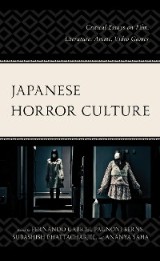Details

Japanese Horror Culture
Critical Essays on Film, Literature, Anime, Video GamesLexington Books Horror Studies
|
44,99 € |
|
| Verlag: | Lexington Books |
| Format: | EPUB |
| Veröffentl.: | 17.11.2021 |
| ISBN/EAN: | 9781793647061 |
| Sprache: | englisch |
| Anzahl Seiten: | 242 |
DRM-geschütztes eBook, Sie benötigen z.B. Adobe Digital Editions und eine Adobe ID zum Lesen.
Beschreibungen
<p><span>Contemporary Japanese horror is deeply rooted in the folklore of its culture, with fairy tales-like ghost stories embedded deeply into the social, cultural, and religious fabric. Ever since the emergence of the J-horror phenomenon in the late 1990s with the opening and critical success of films such as Hideo Nakata’s </span><span>The Ring</span><span> (</span><span>Ringu</span><span>, 1998) or Takashi Miike’s </span><span>Audition</span><span> (</span><span>Ôdishon</span><span>, 1999), Japanese horror has been a staple of both film studies and Western culture. Scholars and fans alike throughout the world have been keen to observe and analyze the popularity and roots of the phenomenon that took the horror scene by storm, producing a corpus of cultural artefacts that still resonate today. Further, Japanese horror is symptomatic of its social and cultural context, celebrating the fantastic through female ghosts, mutated lizards, posthuman bodies, and other figures. Encompassing a range of genres and media including cinema, manga, video games, and anime, this book investigates and analyzes Japanese horror in relation with trauma studies (including the figure of Godzilla), the non-human (via grotesque bodies), and hybridity with Western narratives (including the linkages with Hollywood), thus illuminating overlooked aspects of this cultural phenomenon.</span></p>
<p><span>This book investigates the philosophical, socio-cultural, and artistic world of Japanese horror through a varied range of case studies, including video games (</span><span>Rule of Rose</span><span>), manga (</span><span>Uzumaki</span><span>), and anime (the classic </span><span>Devilman</span><span>). Film is represented with well-known works such as </span><span>Ringu</span><span> and overlooked filmmakers like Mari Asato.</span></p>
<p><span>Introduction: Fernando Gabriel Pagnoni Berns and Subashish Bhattacharjee</span></p>
<p></p>
<p><span>Part 1: National Traumas and Repressions</span></p>
<p><span>Chapter 1: The Ghost of Imperialism: Japan’s Forgotten Horrors in the Shadow of Sadako. Calum Waddell</span></p>
<p><span>Chapter 2: A Modern Monster: Shin-Godzilla and its Place in the Discourse Concerning 3.11 and National Resilience. Barbara Greene</span></p>
<p><span>Chapter 3: Cultural Trauma, Cross-Flow of Aesthetics, and the Child: A Comparison between Ringu and The Ring. Bipasha Mandal</span></p>
<p><span>Chapter 4: Space, Smoke and Mirrors: The Frightening Ambiguity of Ju-On: Origins (2020). Daniel Krátký</span></p>
<p><span>Chapter 5: “The Dead Speak: Horror and the Modern Ghost in Eiji Ōtsuka’s The Kurosagi Corpse Delivery Service. Megan Negrych</span></p>
<p></p>
<p><span>Part 2: Posthuman Monsters and Grotesque Bodies</span></p>
<p><span>Chapter 6: “Love in a Chair”: Industrialization and Exploitation Edogawa Rampo’s “The Human Chair” and Junji Ito’s Manga Adaptation. Leonie Rowland</span></p>
<p><span>Chapter 7: The Monstrous Feminine in Mari Asato’s J-Horror Films. Canela Ailén Rodriguez Fontao and Mariana Zárate</span></p>
<p><span>Chapter 8: Composite Corpses and Viruses of Viewing: J-Horror as Film and Media Theory. William Carroll</span></p>
<p><span>Chapter 9: Spiral into Samsara in Junji Ito’s J-Horror Masterpiece Uzumaki. Wayne Stein</span></p>
<p><span>Chapter 10: Controlling the Inner Demon: Theological Approaches on Devilman. Fernando Gabriel Pagnoni Berns</span></p>
<p></p>
<p><span>Part 3: Cultural Flows </span></p>
<p><span>Chapter 11: The Transpacific Complicity of J-Horror and Hollywood. Seán Hudson</span></p>
<p><span>Chapter 12: Revisiting the Orphan Girl Narrative in Rule of Rose. Ingrid Butler</span></p>
<p><span>Chapter 13: Idol Culture and Gradations of Reality in Japanese Found Footage Horror Films. Dennin Ellis</span></p>
<p><span>Chapter 14: Obscure, Reveal, Repeat: Hidden Worlds and Uncertain Truths in Kōji Shiraishi’s The Curse and Occult. Lindsay Nelson</span></p>
<p></p>
<p><span>About the Editors</span></p>
<p><span>About the Contributors</span></p>
<p></p>
<p></p>
<p><span>Part 1: National Traumas and Repressions</span></p>
<p><span>Chapter 1: The Ghost of Imperialism: Japan’s Forgotten Horrors in the Shadow of Sadako. Calum Waddell</span></p>
<p><span>Chapter 2: A Modern Monster: Shin-Godzilla and its Place in the Discourse Concerning 3.11 and National Resilience. Barbara Greene</span></p>
<p><span>Chapter 3: Cultural Trauma, Cross-Flow of Aesthetics, and the Child: A Comparison between Ringu and The Ring. Bipasha Mandal</span></p>
<p><span>Chapter 4: Space, Smoke and Mirrors: The Frightening Ambiguity of Ju-On: Origins (2020). Daniel Krátký</span></p>
<p><span>Chapter 5: “The Dead Speak: Horror and the Modern Ghost in Eiji Ōtsuka’s The Kurosagi Corpse Delivery Service. Megan Negrych</span></p>
<p></p>
<p><span>Part 2: Posthuman Monsters and Grotesque Bodies</span></p>
<p><span>Chapter 6: “Love in a Chair”: Industrialization and Exploitation Edogawa Rampo’s “The Human Chair” and Junji Ito’s Manga Adaptation. Leonie Rowland</span></p>
<p><span>Chapter 7: The Monstrous Feminine in Mari Asato’s J-Horror Films. Canela Ailén Rodriguez Fontao and Mariana Zárate</span></p>
<p><span>Chapter 8: Composite Corpses and Viruses of Viewing: J-Horror as Film and Media Theory. William Carroll</span></p>
<p><span>Chapter 9: Spiral into Samsara in Junji Ito’s J-Horror Masterpiece Uzumaki. Wayne Stein</span></p>
<p><span>Chapter 10: Controlling the Inner Demon: Theological Approaches on Devilman. Fernando Gabriel Pagnoni Berns</span></p>
<p></p>
<p><span>Part 3: Cultural Flows </span></p>
<p><span>Chapter 11: The Transpacific Complicity of J-Horror and Hollywood. Seán Hudson</span></p>
<p><span>Chapter 12: Revisiting the Orphan Girl Narrative in Rule of Rose. Ingrid Butler</span></p>
<p><span>Chapter 13: Idol Culture and Gradations of Reality in Japanese Found Footage Horror Films. Dennin Ellis</span></p>
<p><span>Chapter 14: Obscure, Reveal, Repeat: Hidden Worlds and Uncertain Truths in Kōji Shiraishi’s The Curse and Occult. Lindsay Nelson</span></p>
<p></p>
<p><span>About the Editors</span></p>
<p><span>About the Contributors</span></p>
<p></p>
<p><span>Fernando Gabriel Pagnoni Berns</span><span> is assistant professor at the Universidad de Buenos Aires.</span></p>
<p></p>
<p><span>Subashish Bhattacharjee</span><span> is assistant professor of English at the University of North Bengal. </span></p>
<p></p>
<p><span>Ananya Saha</span><span> is PhD scholar in the Centre for English Studies, Jawaharlal Nehru University. </span></p>
<p></p>
<p><span>Subashish Bhattacharjee</span><span> is assistant professor of English at the University of North Bengal. </span></p>
<p></p>
<p><span>Ananya Saha</span><span> is PhD scholar in the Centre for English Studies, Jawaharlal Nehru University. </span></p>


















